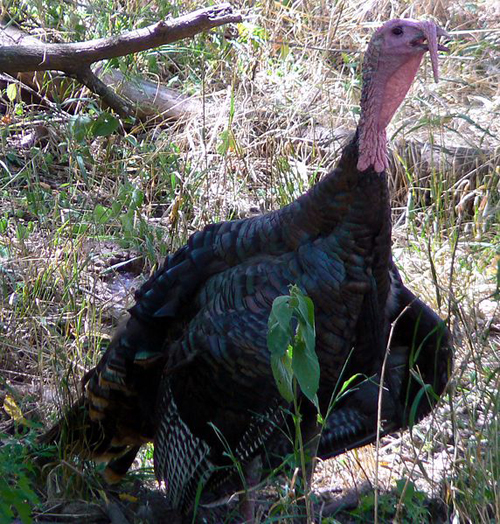About Face
One of my favorite Japanese words contains 面, a kanji that means "face":
面識 (めんしき: acquaintance) face + recognition
If you can recognize someone's face, then that person is your acquaintance! Very logical!
The next compound has 面 at its heart, but the reason is less apparent:
七面鳥 (しちめんちょう: turkey) 7 + faces + bird
According to Japanese Wikipedia, a turkey is called that because its skin is exposed at the head and neck, where there are no feathers. When the skin is stimulated, that area changes colors, making it look as though there are seven faces.
Wait, how would a turkey neck become stimulated or excited? Is it like becoming hot under the collar? Let's see what the Japanese says:
和名の七面鳥の由来は頭部の首のところに裸出した皮膚が興奮すると赤、青、紫などに変化する為にまるで七つの顔(面)を持つ様に見えるという事に由来する。
和名 (わめい: Japanese name (often of plants and animals); 由来* (ゆらい: origin; source; derivation); 頭部 (とうぶ: head); 首 (くび: neck); 裸出 (らしゅつ: exposure); 皮膚 (ひふ: skin); 興奮 (こうふん: excitement; stimulation); 赤 (あか: red); 青 (あお: blue; green); 紫 (むらさき: purple); 変化 (へんか: change); 為に (ために: as a result of); まるで (just like); 七つ (ななつ: 7); 顔 (かお: face); 面 (めん: face); 持つ (もつ: to have); 様に(ように: like, as if); 見える (みえる: to look; seem); 事 (こと: nominalizer)
Hmm, I see no answers there. But the caption I found under the following Wikipedia photo tells me all I need to know: "A wild turkey during mating season." Ah, not hot under the collar but rather hot to trot! A turkey gets excited the same way we all do (aside from the times we feel exuberant about kanji)!

Photo Credit: Riki7
By the way, did you notice who took that photo? Someone by the name of Riki7! Seven seems to be the salient number today.
Even though Wikipedia says that the turkey is indigenous only to North America, Japanese people somehow encountered the bird (probably in the past few centuries) and perceived that transitional, exposed neck area as containing all the colors of the rainbow. I don't mean that literally, even though there are in fact seven primary colors in a rainbow. "All the colors of the rainbow" is just an expression in English, not an exact total. In the same way, the Japanese often use 七 (seven) in a vague way to mean "many, several."
We see that, for example, in these terms:
七転八倒 (しちてんばっとう: falling and rolling many times; writhing in agony)
七転び八起き (ななころびやおき: falling 7 times and getting up 8; never giving up)
七変化 (しちへんげ: 7 transformations; disguising oneself as many people)
七つ道具 (ななつどうぐ: 7 tools; paraphernalia, equipment)
For that matter, the Japanese also use 八 (eight) loosely, as in the first expressions above and in these:
八重桜 (やえざくら: double-flowered cherry tree; double cherry blossoms). This is a type of cherry blossom tree with large, thick flowers that abound in pink petals. They don't just have twice as many petals as a regular cherry blossom. Rather, they differ by an order of magnitude, as you'll see at the links:
blossoms of the double-flowered cherry tree, which English speakers call yaezakura, taking the term straight from Japanese
八面六臂 (はちめんろっぴ: 8 faces and 6 arms; being active in many fields)
Ah, this last expression brings us back to 面!

Photo Credit: Mongo
A wild turkey. The derivation of the English word "turkey" is also interesting. Check English Wikipedia for that.
If you're celebrating Thanksgiving, I hope you can cease to be someone with eight faces and six arms, just for a few days. We all need to rest!
And I hope you spend time with people who are at least your 面識 (めんしき: acquaintances), if not more.
Happy Thanksgiving! See you back here next week.

Photo Credit: George Harrison
Wow, the ocellated turkey, native to Mexico, looks like a rainbow all over!

Comments